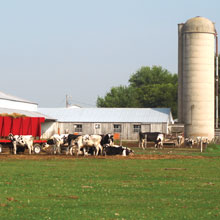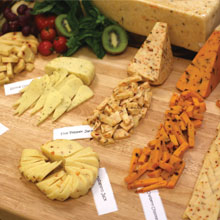
In September, a team of Publix associates visited two of our specialty cheese suppliers. Both companies call Wisconsin home: Henning’s Wisconsin Cheese in Kiel and Meister Cheese Company in Muscoda. They learned about the history of cheesemaking, how cheese is made and what makes each cheese unique.
Last month, Publix News gave you a sneak peek into their new-found knowledge by showing photographs of their trip. Even if you figured out our Publix puzzle, read on to learn more about the cheesemaking process.
Location, location, location
What makes Wisconsin an ideal location for cheesemaking? Cheese lovers can thank Mother Nature.
During the last ice age, glaciers carved the scenery into rolling hills and lush pastures. When Europeans immigrated to the United States, they found the area similar to their homelands, and they turned to farming. Dairy farming was particularly successful — the cooler weather lead to higher milk production — and the excess milk was turned into cheese.
Today, Wisconsin produces more than 600 varieties of cheese, and each year, Wisconsin cheesemakers produce nearly 2.8 billion pounds of cheese.
Holy cow!

Goats and sheep and cows, oh my! Cheesemaking begins with milk, and it takes the best quality milk to make great-tasting cheese.
Cow’s milk is most often used because it has a high fat content, and a wide variety of cheese — more than 300 U.S. varieties — can be made from it. Henning’s and Meister purchase milk from nearby family-owned dairies, where the cows graze in pastures and dine on a supplement of natural grains.
It takes about five quarts of milk to make one pound of whole milk cheese. More than 1.27 million cows are responsible for continuing Wisconsin’s reputation for quality milk. Approximately 90 percent of this milk is used to produce cheese.
Curds and whey

A popular snack that squeaks when you eat them, curds are more than a rhyme for Little Miss Muffet.
The cheesemaking process begins to take shape when the solid curds separate from the liquid whey. The whey is drained, and the curds remain. The more whey a cheesemaker drains from the curds, the drier the cheese will be. Because whey is filled with protein, lactose, vitamins and minerals, it is often added to food and sports drinks, and it’s a main ingredient in high-grade animal feed.
The remaining cheese curds are about the size and shape of peanuts. Every block of cheese you buy is made up of curds that have been pressed together and aged.
A mammoth accomplishment

A special science is involved in making cheese, but who knew there are special classes that focus on cheese technology, artisanship, grading and quality assurance?
The Master Cheesemaker certification requires those classes and more. The state of Wisconsin is the only one to offer this certification, and the program is patterned after the rigorous standards of similar programs in Europe.
A Master Cheesemaker program participant must have at least 10 years’ experience as an active cheesemaker and at least five years’ experience making the cheese variety for which they are seeking certification. Upon completing the program, the student must submit cheese samples to confirm their certification embodies the skill and passion for Wisconsin’s cheesemaking heritage. Only then can a cheese carry the Wisconsin Master’s Mark, which proves it is of the highest quality.
Being named a master cheesemaker is a mammoth accomplishment in itself, but one of our suppliers makes mammoth cheese. While most cheese wheels are 75 pounds, Henning’s mammoth cheddar cheese wheels can be as large as 12,000 pounds.
Technology evolution

The more things change, the more they stay the same. That’s partially true for the cheesemaking process. Technology has changed since this vintage curd mill was used in the early 1900s. But decades later, some parts of the process are still done by hand.
After the whey is drained, the curds are piled up and formed into slabs, and the slabs are turned and piled every 20 minutes. Eventually, the slabs are put through a modern curd mill and cut into smaller pieces. These pieces are salted for flavor, placed into hoop forms and pressed overnight.
A variety of flavors

Has this article made you hungry? Stop by the Publix Deli to try some of our varieties of specialty cheese, and recommend them to your family, friends and customers.
When Publix began its specialty cheese program in 2011, our cheese buyers traveled the globe in search of the best cheeses. Today, the deli offers 28 varieties, about half of which are manufactured domestically.
Both Henning’s and Meister are known for their cheddar, Monterey Jack and other cheeses. The Publix Deli carries many of their specialty flavors like Morel Mushroom and Leek Monterey Jack, Garlic and Pesto Monterey Jack, Bruschetta Jack and Cranberry Cheddar.
Sources: http://www.henningscheese.com/, http://www.meistercheese.com/, http://www.eatwisconsincheese.com/
Publix News Live: Cheese Tour
 Join Publix News Live a team of Publix associates as we tour two of our specialty cheese suppliers’ operations.
Join Publix News Live a team of Publix associates as we tour two of our specialty cheese suppliers’ operations.
Online Exclusive
 Meister Cheese Company – Sustainability
Meister Cheese Company – Sustainability
Scott Meister describes several sustainability programs developed by his Wisconsin cheese company.
 Henning Family Cheese Business
Henning Family Cheese Business
Kerry Henning talks about his family’s 100 year old cheese business.


